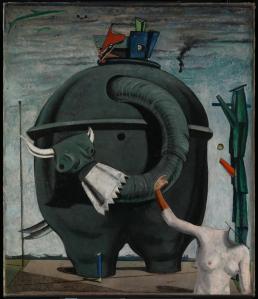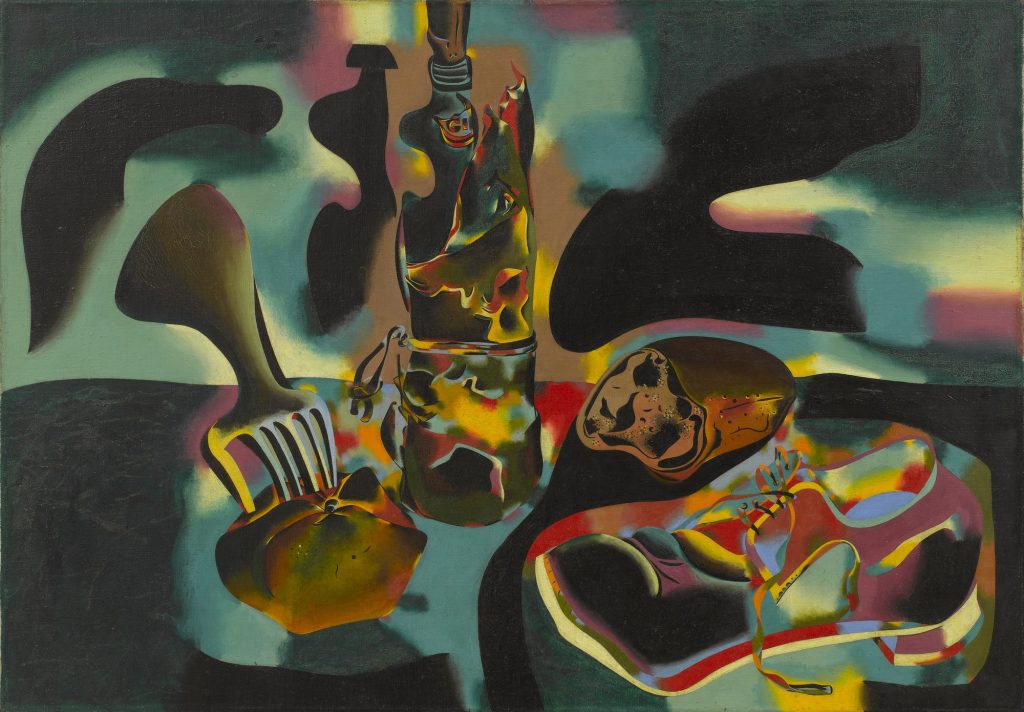Everyone has probably seen at least one piece of Surrealist art somehow. Most likely either Salvador Dalí’s The Persistence of Memory (or more commonly known as ‘The Melting Clocks’) or René Magritte’s The Treachery of Images (an image of a pipe with the text “Ceci n’est pas une pipe”, French for this is not a pipe). Even more likely, you’ve probably used the word surreal to describe a situation or aesthetic.
Beyond being just a misused term and a couple of whacky paintings, Surrealism was an important cultural movement. Engulfing a spectrum of painters, sculptors, writers, and poets, Surrealism became associated with the left-wing movements in post-World War I Western Europe and it’s direct response to the atrocities that many of it’s artists suffered. But it is important to evaluate whether this mostly-french cultural artistic movement supplied Western Europe with any revolutionary potential.
The explanation to what Surrealism is in its artistic context can be found in the etymology of the term. Supposedly first used by French poet Guillaume Apollinaire in 1917, the term was not properly coined until the disputed leader of Surrealism, André Breton, stated that the movement was to…
“Resolve the previously contradictory conditions of dream and reality into an absolute reality, a super-reality”. – The Surrealist Manifesto, 1924[1]
Breton’s interest in this “super-reality” coincided with his own experiences as a psychiatric nurse in the World War, and amongst the discoveries of psychoanalytic studies by Sigmund Freud in the 1900s. Although Freud’s studies which tapped into the unconscious were similar to the artistic practices of what became to be known as the Surrealists, the key difference is that Freud instead used the unconscious to find cures to mental disturbances, whilst Surrealism for the most part used the unconscious as artistic expressionism.
Surrealism started as a mostly literary form of art, in which Breton suggested in The Surrealist Manifesto that a technique to reach a state of the surreal would be to mindlessly write words or drawings onto a page that would take shape into something that would reflect the surreal. [2] This was after Breton abandoned Dadaism. Other techniques that Surrealists used to tap into the unconscious would be dropping a heavy object on the cusp of the mind entering into sleep, in order to wake oneself up and remember the strange thoughts that go on in that relaxed state. This was typically employed by the aforementioned well-known Dalí. Max Ernst instead used frottage in which he would place paper on different surfaces in which shapes would be identified by the artist and developed off of (frottage has a sexual connotation, and despite many artists of Surrealism exploring sexuality, Ernst’ methods were not sexual).

As much as the movement is already beginning to look strange, we can also see that the formation of the movement resembles a lot of socialist movements of the time. A document of intentions published in a ‘manifesto’ already resembles the very beginnings of Marxism. The Surrealists led by Breton also published a magazine on the movement, La Révolution surréaliste, which mostly documented the dreams that people had told them about in great detail. Many other magazines and documents were published in the 1920s and 1930s on the movement. Much like socialist movements, there were separate groupings which often quarrelled about what Surrealism is or what it should achieve. Aside from this, many surrealists were prominent members of their respective Communist and Workers parties. Breton even made acquaintances with Leon Trotsky during his exile.

The critique of the way things are, which so often is the subject of art, is maybe not obvious in the strange and absurd works of Surrealism. One could struggle to find meaning in Ernst’s The Elephant Celebes for instance without knowing it’s biographical context. Some Surrealists may argue that this meaning is purely contained in the sur-reality or the unconscious, and that we don’t know in a state of consciousness. But it could be interpreted that the fact that these pieces that commonly lacked structure could also be reflective of our reality. Central to Marxism is of course the isolation and alienation of the capitalist structure, something that the predominantly male and European artists of the Surrealist movement would have suffered in response to the social and labour consequences of the World War. But also, pieces that portrayed an aesthetically dream-like state such as Dalí’s paintings, something that could possibly be drawn upon the ambition of Communism that a number of artists, including Dalí, held. Magritte absurdly painted the bowler-hat bourgeois men of the time, such as in Golconda in which they all appear to be floating upward from a town.
These interpretations of many of the famous pieces of Surrealism however are unclear. When dealing with art created from the unconsciousness, it is not known to what point the expressions are indeed reflective of the capitalist reality. In fact, much of all of the socialist movements that either succeed or find any grounding rely on a motive to gain consciousness. Consciousness of the reality we are in and the classes that we observe. Creating art that serves to whimsy into states of unconsciousness may not damage revolutionary potential, but is probably not greatly productive on it’s own.
So did Surrealism exist not to reflect capitalism, but to infact disrupt it? Art (and specifically painting and sculpture) is continually synonymous with the capitalist value-form of a dictation of the materials and the hours of labour into a worth that is irrational, and in the case of art often astronomical. The technique of surrealism therefore gave a somewhat effortless and unsettling way of greeting human expression without the necessary materials of classical artistic expression. Art could be made through the stacking of objects in a mindless way and, as often as the bourgeois does not expect of the actions of the proletariat in it’s senses of creation and labour, can lack meaning.
Surrealism was eventually absorbed by bourgeois consumer culture, becoming a trend in the aesthetics of advertising and popular culture – products such as perfumes and alcohol were presented in surreal locations or replicated through a certain artist’s surrealist aesthetic.
The actions of the surrealist artists and the pieces they created are greatly also up for debate over their revolutionary potential. Despite there having been many significant female and non-European surrealist artists, the movement was mostly male and European dominated in the 1920s and into its later period. Subsequently amongst its devolvements into the unconscious and Freudian outlook, much of the art produced was highly sexualised. Although the exploration of sexuality has often been important to all art, particular pieces of work by surrealist artists were simply pornographic, or even displayed scenes of sexual violence. Whether or not these perverse displays were supposed to be for disturbance or pleasure is increasingly unsure when looking further into the movement.
Beyond the art itself, many of the artists were pretty rubbish Communists. Breton and a number of other members of the central grouping were expelled from the Communist Party of France after declaring that proletarian literature was impossible under the bourgeois class.[3] Breton later stated he was an anarchist, and much of the remainder of the movement was passively Trotskyist. Many artists were also sucked into the bourgeois art world, never to comment on socialism again. Surrealism as a movement at-large failed to effectively critique European capitalism, or offer solidarity to existing socialist movements. Surrealism was also later adapted by anti-communist organisations, such as the Orange Alternative, [4] in response and rebellion to socialist realism and socialism.
Two of the most redeeming figures who swam lightly in the rivers of Surrealism were also two of the best known and continually celebrated artists of the 20th century, Frida Kahlo and Pablo Picasso. Kahlo was in fact first spotted by Breton in the late 1930s, with Breton commissioning an exhibition for her. Like Breton, Kahlo was also acquitanced with Trotsky, but was also reportedly rumoured to have contributed in some way to his assassination. Kahlo was never as deep in the cultural and political movement that the original surrealists were, and by the time she was recognised by Breton their movement had begun to fall apart. Picasso’s influence on the movement was different. Also friends with Breton, but significantly older and his work having pre-existed the movement, Picasso was rather unwillingly lumped into the term Surrealism by Breton. Breton and Picasso later fell out over Picasso’s support of both Stalin and the Communist Party, with Picasso also accepting the Lenin Peace Prize in 1962. Kahlo and Picasso most certainly were influenced by Surrealism, however, their deployed techniques differed and with both being less interested in the cultural cause of the movement.
Although it’s hard to ever distinguish whether an artistic or cultural movement has died or was ever significant is difficult, Surrealism does much a favour in being able to answer that it was in fact largely unproductive to the political movements it was associated with. As often as Trotskyism and Anarchism have both been unproductive to existing socialist movements, so was Surrealism. In fact, Surrealism likely was unproductive for the likes of Trotskyism and Anarchism, as it contributed very little beyond whimsy substance to the ideologies. The influences of Surrealism rarely reached the borders of the Soviet Union, and its cultural significance remained firmly within its nest in Parisian-bourgeois Western Europe.
Howard Green, is a member of the YCL’s East of England branch
References:
[1] Breton, A., 1924. Surrealist Manifesto. Markfoster.net. Available at: <http://www.markfoster.net/struc/surrealist_manifesto.pdf> [Accessed 5 January 2022].
[2] Moma.org. n.d. MoMA | Surrealism. [online] Available at: <https://www.moma.org/learn/moma_learning/themes/surrealism/> [Accessed 5 January 2022].
[3] Ades, D., 1974. Dada and Surrealism reviewed. [online] jstor.org. Available at: <https://www.jstor.org/stable/44782622> [Accessed 5 January 2022].
[4] Inyourpocket.com. 2021. The Gnome Revolution: ‘Major’ Fydrych & the Orange Alternative Protest Movement in Wrocław. [online] Available at: <https://www.inyourpocket.com/wroclaw/Alternative-orange-movement_70296f> [Accessed 5 January 2022].



